 THINKING LIKE A
HISTORIAN:
THINKING LIKE A
HISTORIAN:
† PATRIOTS AND
LOYALISTS
†
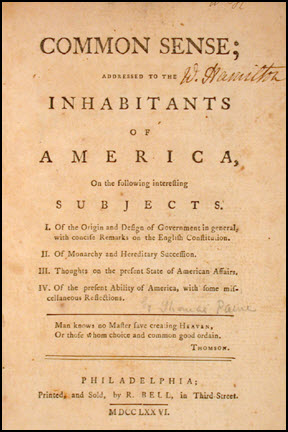
Common Sense by
Thomas Paine:† A Pamphlet from the
Colonial Era
†
Unit
Overview
Americans
sometimes regard their colonial past as a time in which all colonists agreed on
the subject of independence.† In reality,
not everyone thought that a separation from Great Britain was a good idea.† Historians work to correct these types of
false impressions through the careful study of primary and secondary
sources.† The activities in this unit
will help you see how this is accomplished.†
Letís get started.
Primary
and Secondary Sources
When
studying history, it is not unusual to encounter conflicting pieces of
information.† Various eyewitnesses, for
example, may describe a particular event differently.† Some accounts may include details not
mentioned in others or may portray certain occurrences in an opposite
order.† It is the job of a historian to
sift through the material, to analyze the evidence and to separate factual information
from opinion or fiction.† Then, the
findings are used to construct arguments that support a particular
interpretation of the facts.† To do this
work, historians rely on primary and secondary sources.
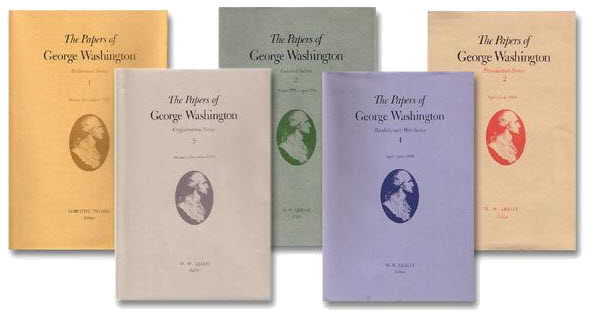
Image Courtesy of
Mount Vernon Ladies' Association
Primary sources provide
first-hand information about historical events and help researchers to learn
what actually happened in a previous era.†
They are based on eye-witness accounts of individuals who lived during
the time period in question.† Diaries,
letters, speeches, legal documents, written laws, newspaper editorials and
journals are all examples of primary sources that have given us valuable
glimpses of life in the past.†
Photographs, audio recordings, literature, cartoons, music and paintings
also have been used to give accurate descriptions of earlier times.† With new developments in technology,
historians analyzing the current century will regard email messages, cell phone
records and posts on social media as primary sources.† Secondary
sources, on the other hand, explain the past by interpreting primary
sources and are written by people who were not present at the events they
discuss.† Examples of secondary sources
include textbooks, encyclopedias, articles from magazines, and television
documentaries.
 † Go to Questions 1 through 4.
† Go to Questions 1 through 4.
Bias
and Primary Sources
Historians
view sources with a critical eye and carefully analyze the information that
they present.† This is especially true of
primary sources.† While they describe the
society and the times in which they were written, these resources reflect the
writerís or creatorís point of view and sometimes slant or ignore certain
facts.† Therefore, it is always important
to take into account when, by whom and for what purpose a primary source was
originally intended.† †
Letís
look at an example.† Four fictional
newspapers from the colonial era are listed below.† Read each description carefully.
∑
The London Daily
Chronicle:† Published in London, England, the Chronicleís staff agrees with the British government.† Its editor has invested in the British East
India Company and believes that saving the business is in the best interest of
the empire.† In his opinion, the
colonists are behaving rebelliously and must be taught a lesson.
∑
The Liberty News:† A member of the Sons of Liberty owns this paper
which is published in Boston.† The editor
favors independence from Great Britain.
∑
The Colonial
Examiner:† The Examiner
is also published in Boston.† The editor
prides himself on balanced and accurate reporting.† He is trying to remain neutral on the subject
of independence.
∑
The Loyal Gazette:† Some colonists, known as Loyalists, did not
consider the taxes imposed by the British to be unfair or to be good reasons to
rebel.† The editor of the Gazette agrees with this
philosophy.† Published in Charles Town
across the harbor from Boston, the paperís editorials frequently reflect his
views.†
Read
the four fictional editorials pictured in the graphics below.† Each one presents a different view of the
Boston Tea Party.
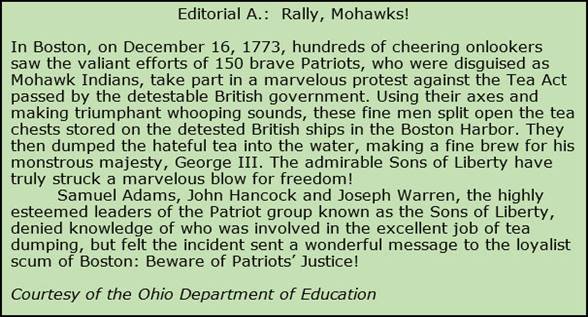
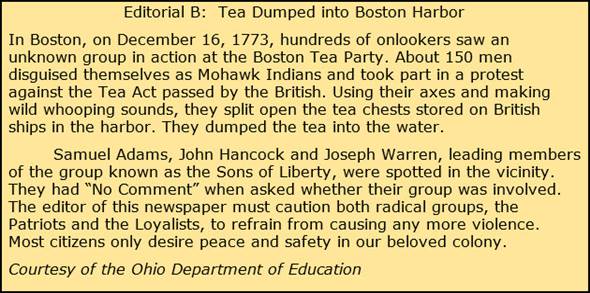
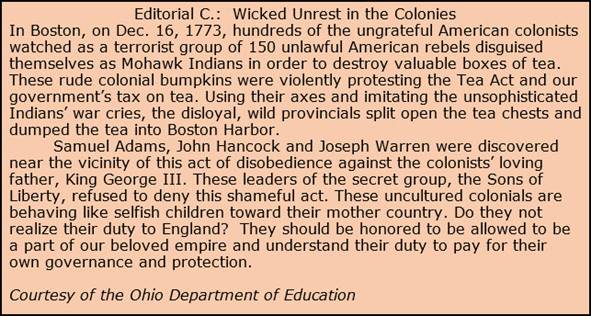
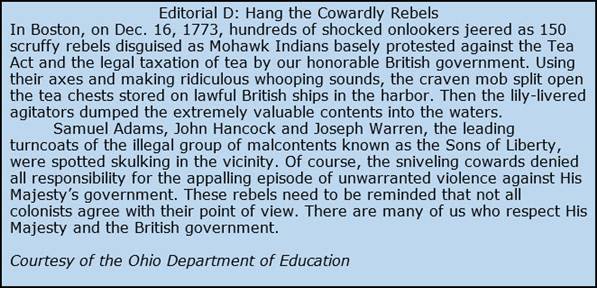
 ††Go to
Questions 5 through 16. ††††
††Go to
Questions 5 through 16. ††††
†††††††††††††††††††††††††††††††††††††††††††††††††††††††††††††††††††††††††††††††††††††††††††††††††††
††
Loyalists and Patriots
Great Britain responded to the Boston Tea Party by issuing
the Coercive or Intolerable Acts, pieces of legislation that led to further
unrest in the colonies.† Some radical
colonists, who were called patriots,
began to consider the idea of separating from Britain, while the loyalists believed that a compromise
with their home country was a better option.†
The First Continental Congress included participants from both groups,
and delegates from each side reacted after the meeting adjourned.† Along with editorials in newspapers,
colonials often published essays on topics of interest in pamphlets, one or more pages that could be cheaply printed and
distributed.† Patriots and loyalists
exchanged opinions on specific topics in what became known as the pamphlet wars.† Samuel Seabury, a loyalist, made his thoughts
on the First Continental Congress public in this manner and drew a response
from Alexander Hamilton, a well-known patriot.†
Read their comments as quoted in the graphics below.
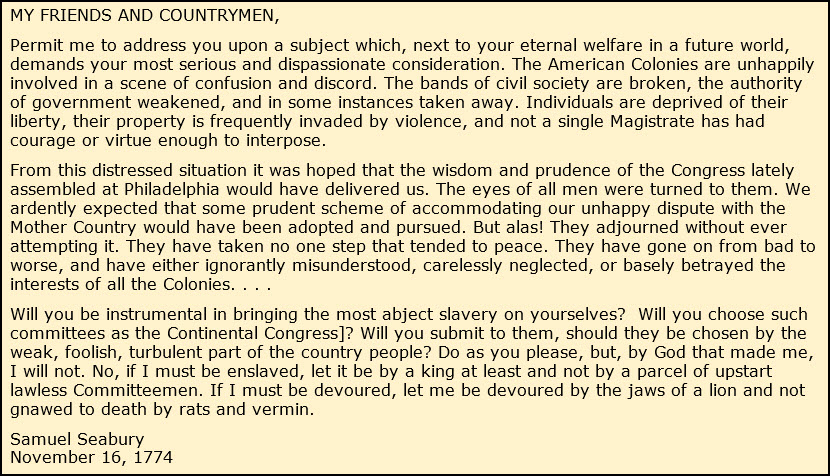
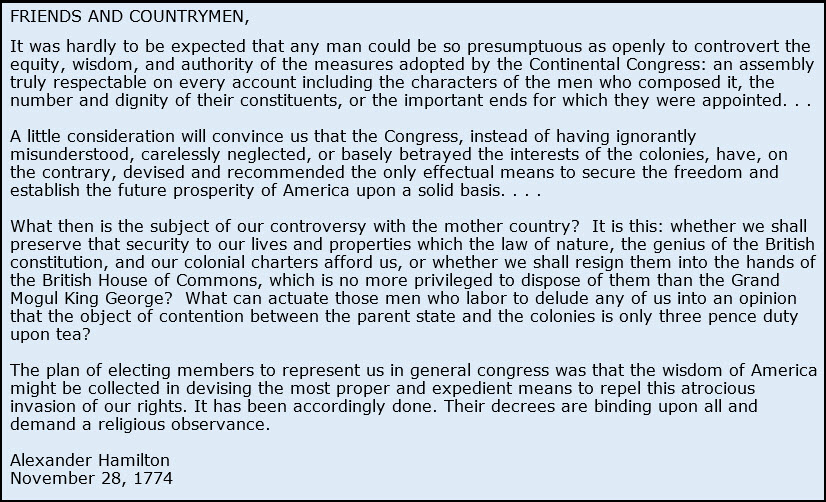
Both
pamphlets, which were printed by James Livingston in New York, were read
throughout the colonies.† In 1775,
members of the Connecticut branch of the Sons of Liberty were so offended by
Seaburyís comments that they traveled to New York, broke into Livingstonís shop
and destroyed his press.†
 † Go to Questions 17 through 25. †
† Go to Questions 17 through 25. †
What
Happened Next?
In
the spring of 1775, the Second Continental Congress assembled in
Philadelphia.† The delegates included
what were to become some of Americaís best-known political figures.† Their decisions, such as the formation of a
Continental Army and a formal declaration of independence, would have a
profound impact on both North American and world history. In the next unit, you
will see just how the big break up became official.†
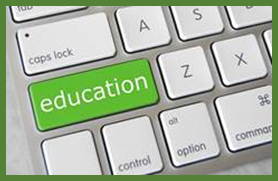
Additional Activities and Resources
Unit 9 Identifying Primary and Secondary Sources Worksheet